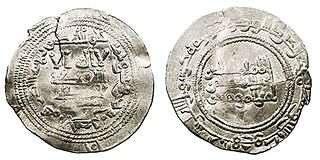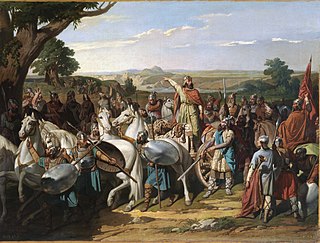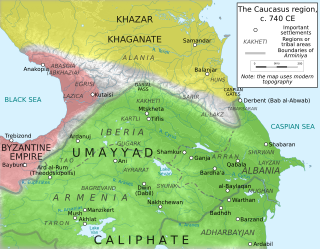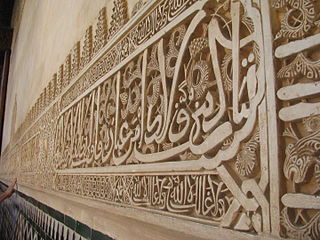
ʿAbd al-Raḥmān ibn Muḥammad ibn ʿAbd Allāh ibn Muḥammad ibn ʿAbd al-Raḥmān ibn al-Ḥakam al-Rabdī ibn Hishām ibn ʿAbd al-Raḥmān al-Dākhil, or simply ʿAbd al-Raḥmān III, was the Umayyad Emir of Córdoba from 912 to 929, at which point he founded the Caliphate of Córdoba, serving as its first caliph until his death. Abd al-Rahman won the laqab (sobriquet) al-Nāṣir li-Dīn Allāh in his early 20s when he supported the Maghrawa Berbers in North Africa against Fatimid expansion and later claimed the title of Caliph for himself. His half-century reign was known for its religious tolerance.

The term Moor is an exonym first used by Christian Europeans to designate the Muslim populations of the Maghreb, al-Andalus, Sicily and Malta during the Middle Ages. Moors are not a single, distinct or self-defined people. The 1911 Encyclopædia Britannica observed that the term had "no real ethnological value." Europeans of the Middle Ages and the early modern period variously applied the name to Arabs, Berbers, and Muslim Europeans.

The Almohad Caliphate or Almohad Empire was a North African Berber Muslim empire founded in the 12th century. At its height, it controlled much of the Iberian Peninsula (Al-Andalus) and North Africa.
Aḥmad ibn Muḥammad al-Maqqarī al-Tilmisānī, (1577-1632) was an Algerian scholar, biographer and historian who is best known for his Nafh at-Tib , a compendium of the history of Al-Andalus which provided a basis for the scholarly research on the subject until the twentieth century.

Al-Andalus was the Muslim-ruled area of the Iberian Peninsula. The term is used by modern historians for the former Islamic states in modern Spain, Portugal, and France. The name describes the different Muslim states that controlled these territories at various times between 711 and 1492. At its greatest geographical extent, it occupied most of the peninsula and part of present-day southern France (Septimania) under Umayyad rule. These boundaries changed constantly through a series of conquests Western historiography has traditionally characterized as the Reconquista, eventually shrinking to the south and finally to the Emirate of Granada.
The golden age of Jewish culture in Spain, which coincided with the Middle Ages in Europe, was a period of Muslim rule during which, intermittently, Jews were generally accepted in society and Jewish religious, cultural, and economic life flourished.
Musa ibn Nusayr served as an Umayyad governor and an Arab general under the Umayyad caliph Al-Walid I. He ruled over the Muslim provinces of North Africa (Ifriqiya), and directed the Islamic conquest of the Visigothic Kingdom in Hispania.

The Kingdom of the Iberians was a medieval Georgian monarchy under the Bagrationi dynasty which emerged circa 888 AD, succeeding the Principality of Iberia, in historical region of Tao-Klarjeti, or upper Iberia in north-eastern Turkey as well parts of modern southwestern Georgia, that stretched from the Iberian gates in the south and to the Lesser Caucasus in the north.
Abū ʿUbayd ʿAbd Allāh ibn ʿAbd al-ʿAzīz ibn Muḥammad ibn Ayyūb ibn ʿAmr al-Bakrī, or simply al-Bakrī was an Arab Andalusian historian and a geographer of the Muslim West.

Battle of Alarcos, was a battle between the Almohads led by Abu Yusuf Ya'qub al-Mansur and King Alfonso VIII of Castile. It resulted in the defeat of the Castilian forces and their subsequent retreat to Toledo, whereas the Almohads reconquered Trujillo, Montánchez, and Talavera.

The Muslim conquest of the Iberian Peninsula by the Umayyad Caliphate occurred between approximately 710 and the 720s. The conquest resulted in the defeat of the Visigothic Kingdom and the establishment of the Umayyad Wilayah of Al-Andalus.
Abu l-Hasan 'Ali Ibn Nafi', better known as Ziryab, Zeryab, or Zaryab, was a singer, oud and lute player, composer, poet, and teacher who lived and worked in Iraq, Northern Africa and Andalusia during the medieval Islamic period. He was also a polymath, with knowledge in astronomy, geography, meteorology, botanics, cosmetics, culinary art and fashion. His nickname "Ziryab", comes from the Persian word for jay-bird زرياب, pronounced "Zaryāb". He was also known as Mirlo ('blackbird') in Spanish. He was active at the Umayyad court of Córdoba in Islamic Iberia. He first achieved fame at the Abbasid court in Baghdad, his birthplace, as a performer and student of the musician and composer Ibrahim al-Mawsili.

Arminiya, also known as the Ostikanate of Arminiya or the Emirate of Armenia, was a political and geographic designation given by the Muslim Arabs to the lands of Greater Armenia, Caucasian Iberia, and Caucasian Albania, following their conquest of these regions in the 7th century. Though the caliphs initially permitted an Armenian prince to represent the province of Arminiya in exchange for tribute and the Armenians' loyalty during times of war, Caliph Abd al-Malik ibn Marwan introduced direct Arab rule of the region, headed by an ostikan with his capital in Dvin. According to the historian Stephen H. Rapp in the third edition of the Encyclopaedia of Islam:
Early Arabs followed Sāsānian, Parthian Arsacid, and ultimately Achaemenid practice by organising most of southern Caucasia into a large regional zone called Armīniya.

The Battle of Sagrajas, also called Zalaca or Zallaqah, was a battle between the Almoravid army led by their King Yusuf ibn Tashfin and an army led by the Castilian King Alfonso VI. The Almoravids responded to the call of Jihad by the taifas which commonly fought amongst themselves however they had united to battle the powerful Christian states to the north. The Taifas aided the Almoravids during the battle with troops, favoring the battle for the Muslim side. The battleground was later called az-Zallaqah because of the poor footing caused by the tremendous amount of bloodshed that day, which gave rise to its name in Arabic.

Lisan ad-Din Ibn al-Khatib was an Arab Andalusi polymath, poet, writer, historian, philosopher, physician and politician from Emirate of Granada. Being one of the most notable poets from Granada, his poems decorate the walls of the palace of Alhambra. He is known for composing the muwashahs entitled "Jadaka al-Ghaithu" and "Lamma Bada Yatathanna."
Ibn Bassām or Ibn Bassām al-Shantarīnī was an Arab-Andalusian poet and historian from al-Andalus. He was born in Santarém and hailed from the Banu Taghlib tribe. He died in 1147.
Ibn Zamrak or Abu Abduallah Muhammad ibn Yusuf ibn Muhammad ibn Ahmad ibn Muhammad ibn Yusuf al-Surayhi, (1333–1393) was an Arab Andalusian poet and statesman from Granada, Al-Andalus. Some his poems still decorate the fountains and palaces of Alhambra in Granada.

The taifa of Zaragoza was an independent Arab Muslim state in the east of Al-Andalus, which was established in 1018 as one of the taifa kingdoms, with its capital in Saraqusta (Zaragoza) city. Zaragoza's taifa emerged in the 11th century following the destruction of the Caliphate of Córdoba in the Moorish controlled Iberian Peninsula.
Ibn Al‐Raqqam Muḥammad Ibn Ibrahim Al‐Mursi Al‐Andalusi Al‐Tunisi Al‐Awsi also known as Ibn Al‐Raqqam was a 13th century Andalusian-Arab astronomer, mathematician and physician; but also a Sunni Muslim theologian and jurist.
Abū ʿAbdallāh Muḥāmmad ibn Masʿūd ibn Ṭayyīb ibn Faraj ibn Khālaṣaal-Ghāfiqī ash-Sheqūrī better known as Ibn 'Abī'l-Khisāl, was a prominent Andalusī secretary, historian, muhaddith and poet. He is referred to as Dhū al-Wizāratayn, an honorific given to senior ministers in medieval Islamic world.










